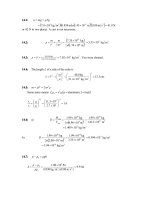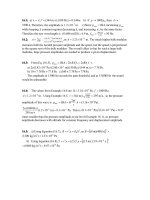- Trang chủ >>
- Khoa Học Tự Nhiên >>
- Vật lý
Tài liệu Physics exercises_solution: Chapter 17 pdf
Bạn đang xem bản rút gọn của tài liệu. Xem và tải ngay bản đầy đủ của tài liệu tại đây (307.24 KB, 34 trang )
17.1: From Eq.
F.1.134327.5659b) F.0.81328.6259a) ,1.17
F.0.88321.3159c)
17.2: From Eq.
C.7.413210795b) C.0.5320.4195a) ,2.17
C.8.2732189/5c)
17.3:
F0.720.40so ,FC1
5
9
F140.2F0.70
12
TT
17.4: a)
C.6.55)440.56(9)5(b) C.2.27))0.4((45.0)95(
17.5:
F,4.104322.4059(17.1),Eq.Froma)
which is cause for worry.
F54or F,6.53321259b)
to two figures.
17.6:
F2.218.1159
17.7:
FC1K1
5
9
, so a temperature increase of 10 K corresponds to an increase
of 18
F
. Beaker B has the higher temperature.
17.8: For
C0.10(a),for Then .C0.10),b(
5
9
C
5
9
FKC
TTTT
.F0.18
17.9: Combining Eq. (17.2) and Eq. (17.3),
,15.27332
9
5
FK
TT
and substitution of the given Fahrenheit temperatures gives a) 216.5 K, b) 325.9 K, c)
205.4 K.
17.10: (In these calculations, extra figures were kept in the intermediate calculations
to arrive at the numerical results.)
)85.126)(5/9(C,12715.273400a)
FC
TT
F.1079.232)1055.1)(5/9(C,1055.115.2731055.1c)
F.28932)15.178)(5/9(C,17815.27395b)F.26032
77
F
77
C
FC
TT
TT
17.11: From Eq.
K.23.2715.273)C92.245(),3.17(
K
T
17.12: From Eq.
C.1769273.15K2042.14K)3.16(7.476)(27),4.17(
17.13: From Eq.
mm.444)mm0.325(),4.17(
K273.16
K15.373
17.14: On the Kelvin scale, the triple point is 273.16 K, so
R.491.69K5(9/5)273.1R
One could also look at Figure 17.7 and note that the
Fahrenheit scale extends from
F32 toF460
and conclude that the triple point is
about 492
R.
17.15: From the point-slope formula for a straight line (or linear regression, which,
while perhaps not appropriate, may be convenient for some calculators),
C,33.282
Pa1080.4Pa106.50
Pa1080.4
)C0.100()C01.0(
44
4
which is
C282
to three figures.
b) Equation (17.4) was not obeyed precisely. If it were, the pressure at the triple
point would be
Pa.1076.4)16.273(
4
15.373
Pa1050.6
4
P
17.16:
C,168m1.62C104.2m1025
1
52
0
αLLT
so the temperature is
C183
.
17.17:
.TL m39.0C)5.0)(Cm)(18.01410)()C(102.1(
15
0
17.18:
)1( Tαddd
C)))78.0(C0.23)()C(10(2.4cm)(14500.0(
15
mm.4.511cm4511.0
17.19: a)
cm,101.4C)(28.0cm)90.1)()C(106.2(
315
0
TαD
so the
diameter is 1.9014 cm. b)
cm,106.3
3
0
TαD
so the diameter is 1.8964 cm.
17.20:
.102.9C)19.5C)(5.00)C(100.2(
415
Tα
17.21:
C0.25m10125.40m103.2)()(
24
0
TLLα
.C103.2
1
5
17.22: From Eq. (17.8),
C.4.49soC,4.29
15
3
0
K101.5
1050.1
TT
β
VV
17.23
L,11C0.9L1700C1075
1
5
0
TVβ
so there is 11 L of air.
17.24: The temperature change is
.C0.14C0.32C0.18 T
The volume of
ethanol contracts more than the volume of the steel tank does, so the additional amount of
ethanol that can be put into the tank is
TVββVV
0ethanolsteelethanolsteel
15
1
5
)C(1075C106.3
33
m0280.0C0.14m80.2
17.25: The amount of mercury that overflows is the difference between the volume
change of the mercury and that of the glass;
.C107.1
0.55cm1000
cm95.8
K100.18
1
5
3
3
15
glass
C
β
17.26: a)
.222,
0
22
ALLLALA
L
L
L
L
But
,Tα
L
L
and so
.22
00
TAαTAαA
b)
.m104.1C5.12)m275.())C(104.2(22
24
2
15
πTAαA
17.27: a)
.cm431.1cm350.1
44
2
2
2
0
ππD
A
b)
.cm437.1C150C1020.121cm431.121
252
0
TαAA
17.28: (a ) No, the brass expands more than the steel.
(b) call
D
the inside diameter of the steel cylinder at
BRST
:C150At C20 DD
cm026.25
)C130)()C(102.1(1
)C130)()C(10(2.01cm)25(
1
)cm(125
)cm25(cm25T
Dcm000.25
15
15
ST
BR
BRST
BRST
Tα
Tα
D
T
αDαD
DD
17.29: The aluminum ruler expands to a new length of
cm048.20)]C100)()C(10(2.4cm)[10.20()1(
15
0
TαLL
The brass ruler expands to a new length of
cm040.20)]C100)()C(10(2.0cm)[10.20()1(
15
0
TαLL
The section of the aluminum ruler will be longer by 0.008 cm
17.30: From Eq. (17.12),
N.100.4
)m10C)(2.01110)()C(10Pa)(2.0109.0(
4
241511
TAYαF
17.31: a)
.)C(102.3)Cm)(400(1.50m)109.1()(
152
0
TLLα
b)
Pa.102.5m)(1.50m)10Pa)(1.9100.2(
9211
0
LLYTYα
17.32: a)
m.105.0m)K)(12.00.35)(K102.1(
315
TLαL
b) Using absolute values in Eq. (17.12),
A
F
Pa.108.4K)0.35)(K10Pa)(1.2100.2(
71511
TYα
17.33: a)
J38)KkgJ1020()Lkg103.1)(L50.0))(C20(C37(
3
b) There will be 1200 breaths per hour, so the heat lost is
J.104.6J)38)(1200(
4
17.34:
s,104.1
) W1200(
)C7)(KkgJ3480)(kg70(
3
P
Tmc
P
Q
t
about 24 min.
17.35: Using Q=mgh in Eq. (17.13) and solving for
Τ
gives
.C53.0
)kg.KJ4190(
)m225)(sm80.9(
2
c
gh
T
17.36: a) The work done by friction is the loss of mechanical energy,
J.1054.1
)sm50.2(
2
1
9.36sin)m00.8)(sm80.9()kg0.35()(
2
1
3
222
2
2
1
vvmmgh
b) Using the result of part (a) for Q in Eq. (17.13) gives
.C1021.1KkgJ3650kg0.35J1054.1
23
T
17.37:
J.1003.3KkgJ470kg30.0KkgJ910kg60.1C20C210
5
17.38: Assuming
,1060.0 KQ
.C1.45
KkgJ910kg1000.8
sm80.7kg80.16
61060.0
3
2
2
1
2
2
1
mc
MV
mc
K
T
17.39:
KkgJ4190kg80.1KkgJ910kg50.1C20.0C0.85
J.1079.5
5
17.40: a)
J.1005.8K0.60KkgJ4190kg320.0
4
TmcQ
b)
s.402
W200
J1005.8
4
P
Q
t
17.41: a)
K.kgJ1051.2
C55.18C54.22kg780.0
W0.65s120
3
Tm
Q
c
b) An overstimate; the heat
Q
is in reality less than the power times the time
interval.
17.42: The temperature change is
soK,0.18T
K.kgJ240
K0.18N4.28
J1025.1sm80.9
42
Tw
gQ
Tm
Q
c
17.43: a)
KkgJ470 , cTmcQ
We need to find the mass of 3.00 mol:
kg1675.0molkg10845.55mol00.3
3
nMm
C114K114KkgJ470kg1675.0J8950mcQT
b) For
C35.6 kg,00.3 mcQTm
c) The result of part (a) is much larger; 3.00 kg is more material than 3.00 mol.
17.44: (a)
kgJ000,30
kg50.0
min5.1minJ000,10
melt
m
Q
L
F
(b)
Tm
Q
cTmcQLiquid
:
CkgJ000,1
C30kg50.0
min5.1minJ000,10
c
CkgJ1300
C15kg50.0
min0.1minJ000,10
:
Tm
Q
cSolid
17.45: a)
0
metalwater
0
metalmetalmetalwaterwaterwater
TcmTcm
0C0.78kg500.0C0.2KkgJ4190kg00.1
metal
c
KJ/kg215
metal
c
b) Water has a larger specific heat capacity so stores more heat per degree of
temperature change.
c) If some heat went into the styrofoam then
metal
Q
should actually be larger than in
part (a), so the true
metal
c
is larger than we calculated; the value we calculated would be
smaller than the true value.
17.46: a) Let the man be designated by the subscript m and the “‘water” by w, and T is
the final equilibrium temperature.
wwwmmm
TCmTCm
wwwmmm
TTCmTTCm
wwwmmm
TTCmTTCm
Or solving for T,
.
wwmm
wwwmmm
CmCm
TCmTCm
T
Inserting numbers, and realizing we can change K to
C
, and the mass of water is .355 kg, we get
)kgJ4190(kg)355.0()kg.J3480(kg)0.70(
)0.12()kgJ4190(kg)355.0()0.37()KkgJ3480(kg)0.70(
CC
CCC
T
Thus,
.85.36 CT
b) It is possible a sensitive digital thermometer could measure this change since
they can read to
.C1.
It is best to refrain from drinking cold fluids prior to orally
measuring a body temperature due to cooling of the mouth.
17.47: The rate of heat loss is
numbers,gInterestin.or ,.
)(
t
Q
tmC
t
TmC
t
Q
ttQ
6.7or d,005.0
dayJ107
C)C)(0.15kg.Jkg)(3480355.70(
6
tt
minutes. This may acount for mothers
taking the temperature of a sick child several minutes after the child has something to
drink.
17.48:
)(
f
LTcmQ
Btu.136kcal34.2J1043.1
kgJ10334K)0.18)(KkgJ(4190kg)350.0(
5
3
17.49:
)(
Vwaterwaterficeice
LTcLTcmQ
Btu.34.5kcal8.69J1064.3
kgJ102256K)kgJ)(4190C100(
kgJ10334)CK)(10.0kgJ(2100
kg)100.12(
4
3
3
3
17.50: a)
.min7.21
)minJ (800
K) K)(15.0kgJkg)(2100550.0(
P
Tmc
P
Q
t
b)
min,230
)minJ(800
)kgJ10kg)(334550.0(
3
f
P
mL
so the time until the ice has melted is
min.252min230min 7.21
17.51:
hr.Btu102.40kW01.7
s)(86,400
)kgJ10334()kglb2.205lb)4000(
4
3
17.52: a)
kgJ102256K)K)(66.0kgJ(4190kg)100.25()(
33
v
LTcm
J.106.91K)K)(66.0kgJkg)(4190100.25(b) J.1033.6
334
Tmc
c) Steam burns are far more severe than hot-water burns.
17.53: With
KQmvKLTcmQ setting,)2/1(and)(
2
f
and solving for
v
gives
.sm357)kgJ105.24CK)(302.3KgJ130(2
3
v
17.54: a)
g.101
)kgJ10(2.42
K)K)(1.00kgJkg)(34800.70(
6
v
sweat
L
TMc
m
b) This much water has a volume of 101
,cm
3
about a third of a can of soda.
17.55: The mass of water that the camel saves is
kg,45.3
)kgJ10(2.42
K)K)(6.0kgJkg)(3480400(
6
v
L
TMc
which is a volume of 3.45 L.
17.56: For this case, the algebra reduces to
C.1.35
).KkgJ4190)(kg240.0(
)KkgJ390)(kg1000.3)(200((
)C0.20)(kgJ4190)(kg240.0(
)C0.100)(KkgJ390))(kg1000.3)(200((
3
3
T
17.57: The algebra reduces to
C5.27
)KkgJkg)(470(0.250
))KkgJkg)(4190(0.170)KkgJkg)(390500.0((
C))(85.0KkgJkg)(470(0.250
C))(20.0KkgJkg)(4190(0.170)KkgJkg)(390500.0((
T
17.58: The heat lost by the sample is the heat gained by the calorimeter and water, and
the heat capacity of the sample is
)Ckg)(73.9(0.0850
)C))(7.1KkgJkg)(390(0.150)KkgJkg)(4190200.0((
Tm
Q
c
=
K,kgJ1010
or
KkgJ1000
to the two figures to which the temperature change is known.
17.59: The heat lost by the original water is
J,10714.4)C0.45)(KkgJ4190)(kg250.0(
4
Q
and the mass of the ice needed is
waterwaterfice
ice
TcLTc
Q
m
ice
)C0.30)(KkgJ4190()kgJ10334()C0.20(K)kgJ(2100
J)10714.4(
3
4
g.94.0kg1040.9
2
17.60: The heat lost by the sample (and vial) melts a mass m, where
g.08.3
)kgJ10(334
K)))(19.5KkgJg)(2800(6.0)KkgJg)(22500.16((
3
f
L
Q
m
Since this is less than the mass of ice, not all of the ice melts, and the sample is
indeed cooled to
C.0
Note that conversion from grams to kilograms was not necessary.
17.61:
kg.10.2
kg)J10334(
)CK)(750kgJkg)(23400.4(
3
17.62: Equating the heat lost by the lead to the heat gained by the calorimeter
(including the water-ice mixtue),
.)()200(
ficecucuicewPb
b
P
LmTcmTcmmTCcm
w
Solving for the final temperature T and using numerical values,
C.4.21
K)kgJkg)(390100.0(
K)kgJkg)(4190178.0(
kgK)Jkg)(130750.0(
kg)J10kg)(334018.0(
)CK)(255kgJkg)(130750.0(
3
T
(The fact that a positive Celsius temperature was obtained indicates that all of the ice
does indeed melt.)
17.63: The steam both condenses and cools, and the ice melts and heats up along with
the original water; the mass of steam needed is
kg.0.190
)C0.72)(kgJ4190(kgJ102256
)CK)(28.0kgJkg)(4190(2.85kg)J10kg)(334450.0(
3
3
steam
m
17.64: The SI units of H and
,mareareaofunits the,both wattsare
2
dt
dQ
temperature
difference is in K, length in meters, so the SI units for thermal conductivity are
.
Km
W
K]][[m
W][m][
2
17.65:
W.10.7m)K400)(m10K)(1.25mWb)(385 m.K222a)
2-4
m0.450
K100
C.73.3m)1000.12)(mK(222Cc)100.0
2
17.66: Using the chain rule,
dt
dm
dt
dQ
LH
f
and solving Eq. (17.21) for k,
K.mW227
K)100)(m10250.1(
s)100.60(
s)600(
kg)1050.8(
)kgJ10334(
24
23
3
f
TA
L
dt
dm
Lk
17.67: (Although it may be easier for some to solve for the heat flow per unit area,
part (b), first the method presented here follows the order in the text.) a) See Example
17.13; as in that example, the area may be divided out, and solving for temperature
T
at
the boundary,
woodwoodfoamfoam
outwoodwoodinfoamfoam
LkLkN
TLkTLk
T
cm0.3Km W080.0cm2.2Km W010.0
C0.10cm0.3Km W080.0C0.19cm2.2Km W010.0
C.8.5
Note that the conversion of the thickness to meters was not necessary. b) Keeping extra
figures for the result of part, (a), and using that result in the temperature difference across
either the wood or the foam gives
m102.2
C767.5C0.19
m W010.0
2
woodfoam
K
A
H
A
H
m100.3
C0.10C767.5
Km W080.0
2
.m W11
2
17.68: a) From Eq.
,21.17
W,196
m100.4
K140
m1040Km W040.0
2
2
H
or
W200
to two figures. b) The result of part (a) is the needed power input.
17.69: From Eq.
,23.17
the energy that flows in time
t
is
J.107.5Btu708h0.5
BtuhFft30
F34ft125
5
2
2
t
R
TA
tH
17.70: a) The heat current will be the same in both metals; since the length of the
copper rod is known,
W.39.5
m00.1
K0.35
m10400Km W0.385
24
H
b) The length of the steel rod may be found by using the above value of
H
in
Eq.
21.17
and solving for
,
2
L
or, since
AH and
are the same for the rods,
m.242.0
K0.35Km W0.385
K0.65Km W2.50
m00.1
22
2
T
T
k
k
LL
17.71: Using
(17.21),Eq.in 17.66)Problem(see
dt
dm
v
LH
kA
L
dt
dm
LT
v
,C5.5
)m150.0)(Km(50.2
m)1085.0(
s)180(
)kg390.0(
)kgJ102256(
2
2
3
W
and the temperature of the bottom of the pot is
C.106C6C100
17.72:
cm0.8m100.8
)m1098.4(4
4D
2
D
m1098.4A
m0.500
K300
Km.
W
2.50sJ150
2
23
2
2
23
π
π
A
ππRA
A
L
T
kA
t
Q









